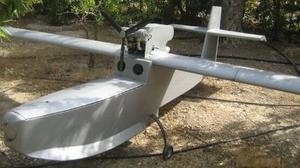UAV updateUAV can withstand severe weather by changing shape
A newly designed UAV can adjust its shape according to wind gusts, with an advanced version of the prototype also allowing for its wings to morph, or twist, based on flight phase and weather patterns; the amphibious aircraft, which can be deployed for search and rescue, forest fire monitoring, and border control, is expected to be commercially available in 2011

Safety through shape-changing // Source: automotto.org
Researchers in Cyprus have developed an unmanned aircraft able to withstand severe weather conditions by changing shape, filling a safety void in rescue operations frequently hampered by extreme weather. We ran a story about the project (“Shape-shifting UAV for maritime search and rescue missions,” 30 August 2010 HSNW), and Reuters offers a few updates. The project, currently under development on the east Mediterranean island, aims to build a small, affordable UAV which can be deployed with minimal risk to remote locations, guided from the ground.
“In severe weather this UAV can stay airborne whereas many other UAVs cannot,” said Dr. Michael Amprikidis, co-ordinator of the project developed by Cyprus’s GG Dedalos Technologies and the Israel Computational Fluid Dynamics Center, their Israeli partner.
Partly funded by the European Union, his team of four have developed a small, portable UAV which can change shape depending on weather gusts. The amphibious aircraft, which can be deployed for search and rescue, forest fire monitoring, and border control, is expected to be commercially
available in 2011. It can adjust its shape according to wind gusts, with an advanced version of the prototype also allowing for its wings to morph, or twist, based on flight phase and weather patterns.
Amprikidis, an aerospace engineer, says the UAV, known as an ASARP (Airborne Search and Rescue Platform), deploys aeroservoelastic trim tabs on its wings which vibrate at certain frequencies to counteract the impact of wind gusts. “All of this happens automatically,” Amprikidis told Reuters in an interview. “There is a PID controller on board the aircraft which takes readings from the sensors which pick up the vertical motion in real time and return the signal straight back to the trim tabs for the ailerons to correct the motions of the aircraft,” he said, referring to flaps on the trailing edge of a wing.
At the moment, the twin-cylinder engine ASARP can feed back images to a control center on the ground within a range of 4.5 miles. Should it move beyond that point, it automatically resumes its collated data feed once back within range, Amprikidis said.
Amprikidis says there has already been interest in the project from the Cypriot government.
The aircraft, which can be transported in boxes and assembled in thirty minutes, has a wingspan of 5 meters (yards), a fuselage length of around 4 meters, and a full payload of 70-75 kg (154-165 lb) with fuel. Amprikidis said it was affordable — most of its avionics were created in-house using commercially available equipment.
The ASARP prototype has already been successfully tested in Cyprus in wind gust conditions of 65 km (40 miles). “It was very stable indeed. It was able to remain airborne and still have a steady course,” Amprikidis said.
The team is now applying other research ideas to the prototype, including morphing wings, which would make the response of the aircraft in heavy weather conditions even more efficient. “We hope it would be commercially available during 2011,” Amprikidis said.
The ASARP would not alleviate all potential threats to flying in bad weather, but does remove the risk to some crews working in such conditions, he said.
